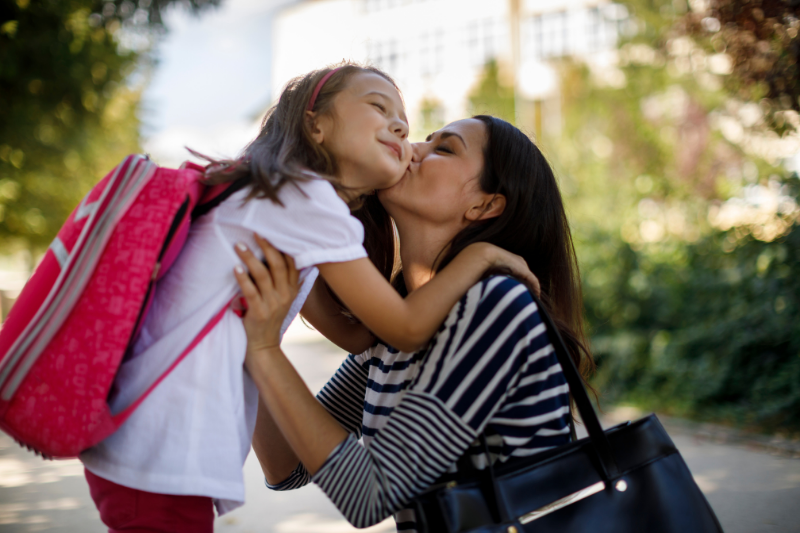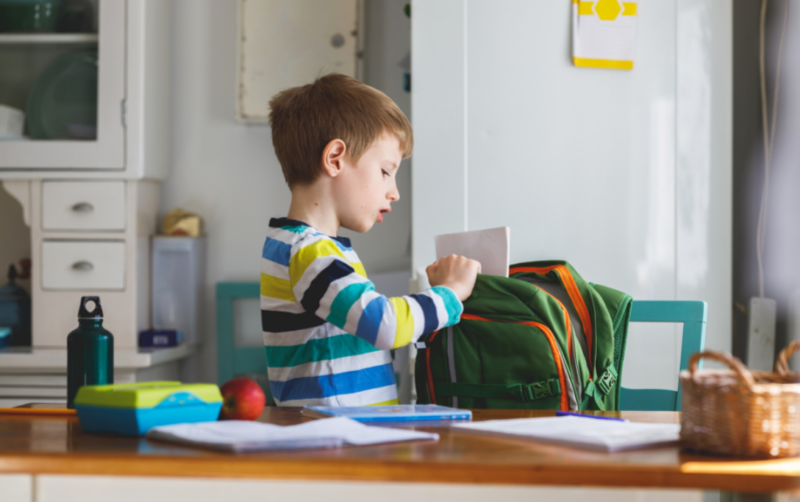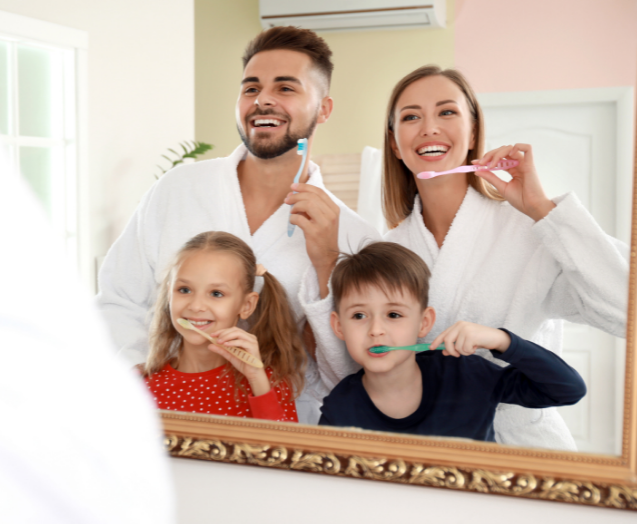Creating an ADHD-Friendly Morning Routine with Your Family: Wake up to a smoother start and a better day
 Let’s face it–busy mornings can be stressful. It’s difficult to stay calm and collected with so much to do within a short period of time. For kids with ADHD, there are often additional stumbles and delays when they forget something, get distracted or need to make decisions on the go. Help your child, and yourself, by establishing an effective ADHD morning routine that will reduce stress and make it easier to get out the door. You can accomplish this with 3 key strategies: Get organized, plan ahead and motivate your child effectively. With a bit of preparation and a dash of flexibility, you can establish morning routines that reduce arguments and promote a calmer start to the day. With clear expectations, meaningful incentives and effective cueing, you can transform unpleasant mornings into better ones.
Let’s face it–busy mornings can be stressful. It’s difficult to stay calm and collected with so much to do within a short period of time. For kids with ADHD, there are often additional stumbles and delays when they forget something, get distracted or need to make decisions on the go. Help your child, and yourself, by establishing an effective ADHD morning routine that will reduce stress and make it easier to get out the door. You can accomplish this with 3 key strategies: Get organized, plan ahead and motivate your child effectively. With a bit of preparation and a dash of flexibility, you can establish morning routines that reduce arguments and promote a calmer start to the day. With clear expectations, meaningful incentives and effective cueing, you can transform unpleasant mornings into better ones.
Step 1: Reflect on your current morning routine
What already works? What can be improved?
 Before you can create an ADHD morning routine that works for your family, consider what’s already working well. Then, consider what could be improved. For example, if your child cheerfully comes to the breakfast table on time, then keep doing what you’re already doing. On the other hand, if your teen has a difficult time getting out of bed independently, then that’s an area for improvement.
Before you can create an ADHD morning routine that works for your family, consider what’s already working well. Then, consider what could be improved. For example, if your child cheerfully comes to the breakfast table on time, then keep doing what you’re already doing. On the other hand, if your teen has a difficult time getting out of bed independently, then that’s an area for improvement.
Step 2: Collaborate on ADHD-friendly morning routine ideas in a family meeting
Identify morning tasks:
Take the stress out of your morning by collaboratively creating an organizational roadmap with your family members. In a family meeting, talk about what needs to be accomplished each morning. Ask your child to identify the tasks they need to do each morning, like getting dressed, brushing teeth and eating breakfast.
Decide which morning tasks are priorities:
Next, think about and decide which tasks are an absolute priority for your household, and what is a “nice-to-have.” If brushing teeth is non-negotiable, then carve out time for it each morning. Don’t spend your limited time and energy pushing your child into doing something that’s not a priority. Instead, focus on the truly important things. Be sure to clearly communicate these morning “must haves” to your child.
Plan the steps for completing tasks:
 Brainstorm ideas for completing these tasks. Since ADHD affects your child’s ability to focus on non-desired tasks, it can be tough to focus on getting dressed, eating breakfast or putting on their shoes. Limit distractions and interruptions like TV, phone or computer use during the morning rush. Remember, there is no one right way of doing things. Your outside-the-box thinker may have some creative approaches that are worth considering. An effective ADHD routine is one which meets your family’s individual needs based on what works and what could be fine-tuned.
Brainstorm ideas for completing these tasks. Since ADHD affects your child’s ability to focus on non-desired tasks, it can be tough to focus on getting dressed, eating breakfast or putting on their shoes. Limit distractions and interruptions like TV, phone or computer use during the morning rush. Remember, there is no one right way of doing things. Your outside-the-box thinker may have some creative approaches that are worth considering. An effective ADHD routine is one which meets your family’s individual needs based on what works and what could be fine-tuned.
Step 3: Consider priorities, obstacles and opportunities for better organization
Prioritize rest and nutrition:
Of course, adequate rest and nutrition improve the start to any day. Make sure to build in extra time for winding down in the evening and waking up in the morning, as these can be challenging for kids with ADHD. It’s common for many teens with ADHD to struggle to wake up in the morning. Talk to your child’s primary care provider about this issue to rule out any biological complications.
Try these tips:
-
- Turn off electronic devices at least an hour before bedtime
- Honor bedtimes and wake-up times
- Try relaxing evening activities like reading, listening to music, yoga/stretching, coloring/drawing or family meditation to help ease into sleep
- Use two alarms in morning, ideally one across the room that requires movement out of bed to turn it off
- Provide fun, healthy breakfast options like waffles with whipped cream and berries, mystery smoothies or peanut butter sandwiches cut into goofy shapes
Prep the house with clear organization:
 Keeping track of everybody’s stuff can also reduce morning chaos. Work together to create a home for specific things such as gloves and hats, lunchboxes, keys and phones. Cubbies, milk crates, baskets, hooks or clear plastic boxes can be lifesavers. Using labels to add visual cues can be helpful. When everything has a place of its own, you and your children will spend less time running around looking for that missing boot, wallet or permission slip. My dad always said, “Everything needs to have a place to put it.” As usual, he’s right–it’s just hard sometimes to make that place happen. Taking time in the short run to figure this out (starting with the important stuff to reduce your overwhelm) will pay off in the long run.
Keeping track of everybody’s stuff can also reduce morning chaos. Work together to create a home for specific things such as gloves and hats, lunchboxes, keys and phones. Cubbies, milk crates, baskets, hooks or clear plastic boxes can be lifesavers. Using labels to add visual cues can be helpful. When everything has a place of its own, you and your children will spend less time running around looking for that missing boot, wallet or permission slip. My dad always said, “Everything needs to have a place to put it.” As usual, he’s right–it’s just hard sometimes to make that place happen. Taking time in the short run to figure this out (starting with the important stuff to reduce your overwhelm) will pay off in the long run.
Do more the night before:
Morning routines can be made more efficient by moving some of the to-dos to the night before. By shifting tasks to the previous evening, you can take a lot of pressure off of your busy morning. This also reduces the chances of unpleasant surprises or frustrating power struggles. Being prepared decreases the need to rush, worry or make hasty decisions. Here are some tasks which can be done in the evening in order to save time and ensure things go smoothly:
-
- Lay out clothes
- Prepare breakfast and/or lunch
- Pack backpack with books/supplies/homework
- Gather gear and equipment needed for after-school sports or clubs
- Set the breakfast table after dinner cleanup is done
Step 4: Decide on a plan to start with
 When you’ve gathered the information you need to create a plan, it’s time to decide on one to start with. This plan will likely be adjusted later after trial-and-error, but decide on a first plan to start implementing. Having a basic plan that clearly shows the necessary steps for leaving the house will help mornings go smoother. Creating a plan ahead of time also takes the pressure off of exercising some executive functions in the morning that can be difficult for kids and teens with ADHD, such as planning, sequencing and prioritizing. Create a schedule that includes time estimates, the agreed upon morning tasks and any specific instructions for completing the tasks. Using backwards design will help you come up with time estimations. You’ll also want to add in extra time for the unexpected in your calculations.
When you’ve gathered the information you need to create a plan, it’s time to decide on one to start with. This plan will likely be adjusted later after trial-and-error, but decide on a first plan to start implementing. Having a basic plan that clearly shows the necessary steps for leaving the house will help mornings go smoother. Creating a plan ahead of time also takes the pressure off of exercising some executive functions in the morning that can be difficult for kids and teens with ADHD, such as planning, sequencing and prioritizing. Create a schedule that includes time estimates, the agreed upon morning tasks and any specific instructions for completing the tasks. Using backwards design will help you come up with time estimations. You’ll also want to add in extra time for the unexpected in your calculations.
Step 5: Prepare for success
Create a physical checklist that’s easily accessible:
A detailed checklist provides a practical way to help your child or teen stay on task and not forget anything important. When kids know what to do, and can mark their progress along the way, they are more likely to participate instead of obstruct. Write down the ADHD-friendly morning routine steps on a white board or tape it to the refrigerator. This reduces the need for guesswork or on-the-fly decision-making. Consider pinning a laminated list of what’s needed each day for school inside the backpack itself.
Create meaningful incentives:
 Set up effective, age-appropriate and meaningful incentives to motivate your child or teen to cooperate with your agreed-upon routines. Incentives motivate kids with ADHD to stick with the program and complete tasks they may find boring or unsatisfying. For example, if your 6-year-old hates brushing their teeth, incentivize them with reading a story or playing a card game before school. Or, brush your teeth alongside them to a fun song. Older kids may be enticed to get out of bed in the morning if the incentive is getting a donut on the way to school or earning bonus screen time before dinner. It is much more effective to motivate kids with ADHD with incentives that matter to them rather than punishments linked to a loss of privileges. In addition, your child will be more cooperative in getting through their morning checklist if you get them involved in creating it and give them a say in choosing reasonable incentives.
Set up effective, age-appropriate and meaningful incentives to motivate your child or teen to cooperate with your agreed-upon routines. Incentives motivate kids with ADHD to stick with the program and complete tasks they may find boring or unsatisfying. For example, if your 6-year-old hates brushing their teeth, incentivize them with reading a story or playing a card game before school. Or, brush your teeth alongside them to a fun song. Older kids may be enticed to get out of bed in the morning if the incentive is getting a donut on the way to school or earning bonus screen time before dinner. It is much more effective to motivate kids with ADHD with incentives that matter to them rather than punishments linked to a loss of privileges. In addition, your child will be more cooperative in getting through their morning checklist if you get them involved in creating it and give them a say in choosing reasonable incentives.
Step 6: Check-in, adjust and try again
 There is always the chance that, despite your best efforts, your new ADHD morning routine won’t work as well or as quickly as you’d like. Remember that it’s a process. You may need to make several adjustments tailored to your family’s unique needs, preferences and goals before finding what works. If you get pushback, try to be patient. Adjust your expectations, and try to address one improvement at a time. On the morning that things don’t go according to plan, try to stay cool, manage your emotions and keep your sense of humor. And when things do go well, give your child genuine praise and encouragement. Celebrating these wins will give you and your child further motivation to commit to effective routines for a more calm and pleasant family life.
There is always the chance that, despite your best efforts, your new ADHD morning routine won’t work as well or as quickly as you’d like. Remember that it’s a process. You may need to make several adjustments tailored to your family’s unique needs, preferences and goals before finding what works. If you get pushback, try to be patient. Adjust your expectations, and try to address one improvement at a time. On the morning that things don’t go according to plan, try to stay cool, manage your emotions and keep your sense of humor. And when things do go well, give your child genuine praise and encouragement. Celebrating these wins will give you and your child further motivation to commit to effective routines for a more calm and pleasant family life.
Read more blog posts:
- New Year, New Habits, Same ADHD: How to plan for and maintain new habits together, as a family
- Productive Procrastination and ADHD: How to stop running in place and start tackling your goals
- Parenting Neurodivergent Kids with a Growth Mindset: How you can take ‘failure’ out of your vocabulary
Watch on Dr. Saline’s YouTube Channel:
- ADHD Communication Tips: Conveying ideas, feelings & frustrations
- Initiating and Completing Tasks with ADHD
- How Do I Manage Screen Time and ADHD?
Handouts, Videos & More in Dr. Saline’s Store: https://drsharonsaline.com/product/homework/ https://drsharonsaline.com/product/home-seminar/
